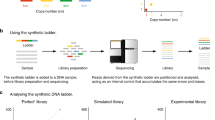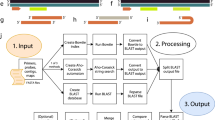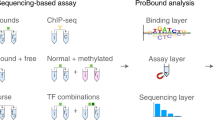Abstract
Hybridization is a key molecular process in biology and biotechnology, but so far there is no predictive model for accurately determining hybridization rate constants based on sequence information. Here, we report a weighted neighbour voting (WNV) prediction algorithm, in which the hybridization rate constant of an unknown sequence is predicted based on similarity reactions with known rate constants. To construct this algorithm we first performed 210 fluorescence kinetics experiments to observe the hybridization kinetics of 100 different DNA target and probe pairs (36 nt sub-sequences of the CYCS and VEGF genes) at temperatures ranging from 28 to 55 °C. Automated feature selection and weighting optimization resulted in a final six-feature WNV model, which can predict hybridization rate constants of new sequences to within a factor of 3 with ∼91% accuracy, based on leave-one-out cross-validation. Accurate prediction of hybridization kinetics allows the design of efficient probe sequences for genomics research.
This is a preview of subscription content, access via your institution
Access options
Access Nature and 54 other Nature Portfolio journals
Get Nature+, our best-value online-access subscription
$29.99 / 30 days
cancel any time
Subscribe to this journal
Receive 12 print issues and online access
$259.00 per year
only $21.58 per issue
Buy this article
- Purchase on Springer Link
- Instant access to full article PDF
Prices may be subject to local taxes which are calculated during checkout






Similar content being viewed by others
References
Hamilton, A. J. & Baulcombe, D. C. A species of small antisense RNA in posttranscriptional gene silencing in plants. Science 286, 950–952 (1999).
Kornberg, A. & Baker, T. A. DNA Replication (Freeman, 1992).
Lewis, B. P., Burge, C. B. & Bartel, D. P. Conserved seed pairing, often flanked by adenosines, indicates that thousands of human genes are microRNA targets. Cell 120, 15–20 (2005).
Izkoviz, S. & van Oudenaarden, A. Validating transcripts wih probes and imaging technology. Nat. Methods 8, S12–S19 (2011).
Lockhart, D. J. et al. Expression monioring by hybridization to high-densiy oligonucleotide arrays. Nat. Biotechnol. 14, 1675–1680 (1996).
Gnirke, A. et al. Solution hybrid selection wih ultra-long oligonucleotides for massively parallel targeted sequencing. Nat. Biotechnol. 27, 182–189 (2009).
Khodakov, D., Wang, C. & Zhang, D. Y. Diagnostics based on nucleic acid sequence variant profiling: PCR, hybridization, and NGS approaches. Adv. Drug Delivery Rev. 105, 3–19 (2016).
Mathews, D. H., Sabina, J., Zuker, M. & Turner, D. H. Expanded sequence dependence of thermodynamic parameters improves prediction of RNA secondary structure. J. Mol. Biol. 288, 911–940 (1999).
SantaLucia, J. & Hicks, D. The thermodynamics of DNA structural motifs. Ann. Rev. Biochem. 33, 415–440 (2004).
Zuker, M. Mfold web server for nucleic acid folding and hybridization prediction. Nucleic Acids Res. 31, 3406–3415 (2003).
Zadeh, J. N. et al. NUPACK: analysis and design of nucleic acid systems. J. Comput. Chem. 32, 170–173 (2011).
Morrison, L. E. & Stols, L. M. Sensitive fluorescence-based thermodynamic and kinetic measurements of DNA hybridization in solution. Biochemistry 32, 3095–3104 (1993).
Reynaldo, L. P., Vologodskii, A. V., Neri, B. P. & Lyamichev, V. I. The kinetics of oligonucleotide replacements. J. Mol. Biol. 297, 511–520 (2000).
Zhang, D. Y. & Winfree, E. Control of DNA strand displacement kinetics using toehold exchange. J. Am. Chem. Soc. 131, 17303–17314 (2009).
Ouldridge, T. E., Šulc, P., Romano, F., Doye, J. P. K. & Louis, A. A. DNA hybridization kinetics: zippering, internal displacement and sequence dependence. Nucleic Acids Res. 41, 8886–8895 (2013).
Schreck, J. S. et al. DNA hairpins destabilize duplexes primarily by promoting melting rather than by inhibiting hybridization. Nucleic Acids Res. 43, 6181–6190 (2015).
Cisse, I. I., Kim, H. & Ha, T. A rule of seven in Watson–Crick base-pairing of mismatched sequences. Nat. Struct. Mol. Biol. 19, 623–627 (2012).
Jungmann, R. et al. Single-molecule kinetics and super-resolution microscopy by fluorescence imaging of transient binding on DNA origami. Nano Lett. 10, 4756–4761 (2010).
He, G., Li, J., Ci, H., Qi, C. & Guo, X. Direct measurement of single-molecule DNA hybridization dynamics with single-base resolution. Angew. Chem. Int. Ed. 55, 9036–9040 (2016).
Wang, J. S. & Zhang, D. Y. Simulation-guided DNA probe design for consistently ultraspecific hybridization. Nat. Chem. 7, 545–553 (2015).
Gao, Y., Wolf, L. K. & Georgiadis, R. M. Secondary structure effects on DNA hybridization kinetics: a solution versus surface comparison. Nucleic Acids Res. 34, 3370–3377 (2006).
van Dijk, E. L., Auger, H., Jaszczyszyn, Y. & Thermes, C. Ten years of next-generation sequencing technology. Trends Genet. 30, 418–426 (2014).
Koboldt, D. C., Steinberg, K. M., Larson, D. E., Wilson, R. K. & Mardis, E. R. The next-generation sequencing revolution and is impact on genomics. Cell 155, 27–38 (2013).
Chilamakuri, C. S. et al. Performance comparison of four exome capture systems for deep sequencing. BMC Genomics 15, 449 (2014).
Clark, M. J. et al. Performance comparison of exome DNA sequencing technologies. Nat. Biotechnol. 29, 908–914 (2011).
Snyder, M. W., Kircher, M., Hill, A. J., Daza, R. M. & Shendure, J. Cell-free DNA comprises an in vivo nucleosome footprint that informs is tissues-of-origin. Cell 164, 57–68 (2016).
Denoeux, T. A k-nearest neighbor classification rule based on Dempster–Shafer theory. IEEE Trans. Syst. Man Cybern. 25, 804–813 (1995).
Wand, M. P. & Jones, M. C. Kernel Smoothing (CRC Press, 1994).
Acknowledgements
The authors thank S.X. Chen for assistance with NGS sequence alignment. This work was funded by National Institutes of Health grant R01HG008752 to D.Y.Z.
Author information
Authors and Affiliations
Contributions
J.X.Z., L.R.W. and D.Y.Z. conceived the project. J.X.Z. and A.W.Z. performed the experiments. N.D. and A.P. performed hybridization reaction model fitting and selection. J.X.Z., J.Z.F., B.Y. and R.P. performed feature construction. W.D. and D.Y.Z. performed WNV model construction and optimization. N.D., B.Y. and R.P. performed MLR model construction and optimization. D.Y.Z. wrote the manuscript with input from all authors.
Corresponding author
Ethics declarations
Competing interests
There is a patent pending on the X-probes used in this work, and a patent pending on the WNV model of hybridization rate constant prediction.
Supplementary information
Supplementary information
Supplementary information (PDF 11583 kb)
Rights and permissions
About this article
Cite this article
Zhang, J., Fang, J., Duan, W. et al. Predicting DNA hybridization kinetics from sequence. Nature Chem 10, 91–98 (2018). https://doi.org/10.1038/nchem.2877
Received:
Accepted:
Published:
Issue Date:
DOI: https://doi.org/10.1038/nchem.2877
This article is cited by
-
Non-complementary computation
Nature Chemistry (2023)
-
Generation of DNA oligomers with similar chemical kinetics via in-silico optimization
Communications Chemistry (2023)
-
Non-complementary strand commutation as a fundamental alternative for information processing by DNA and gene regulation
Nature Chemistry (2023)
-
Limitations and opportunities of technologies for the analysis of cell-free DNA in cancer diagnostics
Nature Biomedical Engineering (2022)
-
Functionalizing DNA origami to investigate and interact with biological systems
Nature Reviews Materials (2022)



